#Akiman Yasuda
Explore tagged Tumblr posts
Text
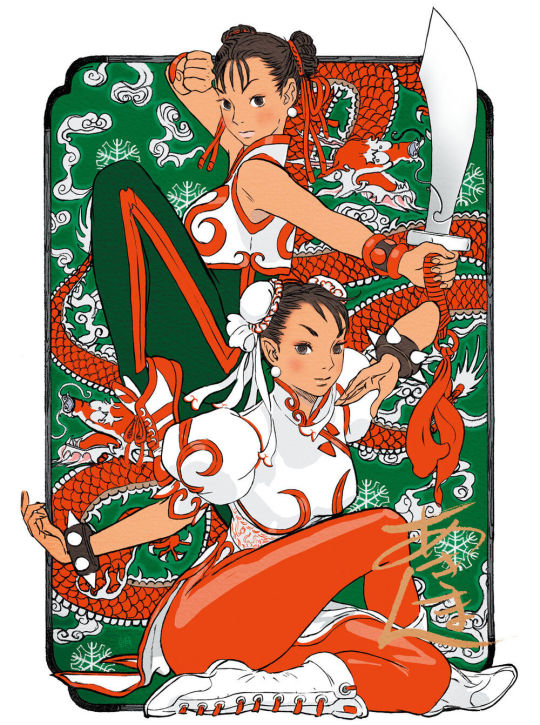
Hyper Street Fighter II - for e-CAPCOM sales promotion: by Akiman
#Hyper Street Fighter II #official art#Akiman#Akiman Yasuda#Chun-Li#Street fighter 2 franchise#Capcom#Videogames#Chinese character#Chinese characters
9 notes
·
View notes
Photo
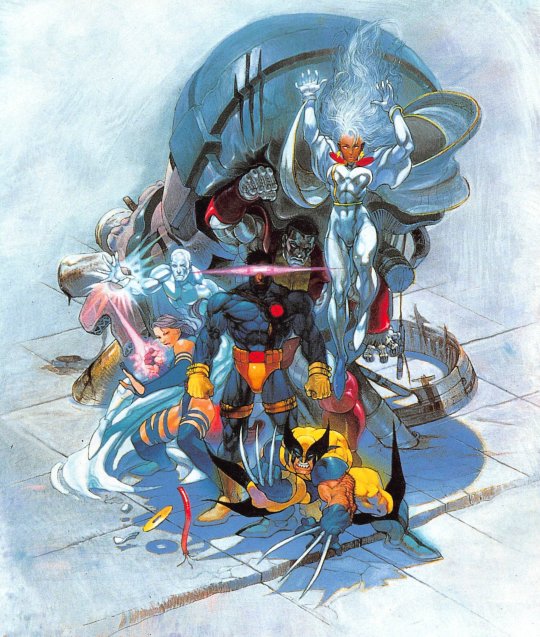
X-Men: Children of the Atom by Akiman
#Capcom#X-Men#X-Men: Children of the Atom#illustration#arcade#video games#retro gaming#Akira Yasuda#Akiman
577 notes
·
View notes
Text

Key artwork from the 1994 Capcom Arcade game
X-Men: Children of the Atom / エックス・メン チルドレン オブ ジ アトム
Art by Akira "Akiman" Yasuda
Follow Randomised Gaming on Tumblr, YouTube, Twitch & Twitter for video gaming & video content! Buy us a tea on Ko-fi
#X-Men: Children of the Atom#1994#エックス・メン チルドレン オブ ジ アトム#Akira “Akiman” Yasuda#Arcade#Capcom#X-Men#90s#Marvel#MARVEL vs. CAPCOM Fighting Collection: Arcade Classics
13 notes
·
View notes
Text

X-Men Children of the Atom Video Game (Japanese Import) / Released: 1995 / Artist: Akiman Akira Yasuda
21 notes
·
View notes
Text
Suspicious Anatomical Illustration
A long time ago an art blogger named GVAAT translated Capcom's internal anatomy guide, which Capcom USA very oddly referred to as "Suspicious Anatomical Illustration"
But GVAAT didn't put his translations on the images, which made it kind of hard to go back and forth between the text and pictures, so I learned GIMP just to add the English text.













Not everything is translated and I can't 100% guarantee it's correct, but this guide is by the legendary Street Fighter artist Akira Yasuda, AKA Akiman, and is definitely worth a look.
11 notes
·
View notes
Text
#capcom#street fighter#devil may cry#resident evil#dragon's dogma#bengus#kinu nishimura#akiman#akira yasuda#daigo ikeno#shinkiro#tatsuya yoshikawa
4 notes
·
View notes
Text



Original Murata illustrations were sent to all of the artists who contributed art to the BRAINxBRAVE special volume - via X/twitter user @eyeshield21bxb (pt 1 / pt 2).
These are for artists Akiman/Yasuda Akira (Streetfighter), Akimoto Osamu (KochiKame), and Aimoto Sho (Kemono Jihen) respectively, featuring characters they designed/from their manga along with Eyeshield 21 characters.
146 notes
·
View notes
Text

Street Fighter II promotional artwork by Akira "Akiman" Yasuda. (Source)
#Street Fighter II: The World Warrior#Arcade#Capcom#1991#illustrations#fighting games#Akiman#Street Fighter
15 notes
·
View notes
Text

The Anime Influence of Side Arms
Side Arms sits in the middle of Capcom’s loose “Flying Guy” trilogy. While not particularly obscure, it’s generally not as well known as its related games, Section Z and Forgotten Worlds, because its only contemporary console port was to the TurboGrafx-16. Side Arms was the debut work of artist Akira “Akiman” Yasuda, who became world renowned for his later work on the Street Fighter series. It also shamelessly wears its Gundam inspiration on its head. One of the regular enemies you’ll fight are basically just the Zaku robots, famous for its red Cyclops-like eye.
Read more...
#side arms#capcom#arcade#anime#hardcore gaming 101#kurt kalata#feature#trivia tidbits#video games#retro games
13 notes
·
View notes
Text
032: Tetris the Grand Master, or how Street Fighter and Japanese comedy changed Tetris forever

CANON FIRE is made possible by the generous contributions of readers like you. Support more writing like this on Patreon. Thank you!
When you think of Tetris you probably think of Game Boy Tetris, the NES World Championship, or maybe even Tetris DS. What you probably don't think of is Street Fighter, or Japanese comedy. But that's exactly the lineage that led to the creation of Tetris the Grand Master.
TGM is now known for its ludicrous speeds and intense difficulty, but despite its reputation, it's also the origin of several features that would make Tetris easier to play, and a crucial step in the development of modern tetris.

Let's rewind a bit. Before we talk TGM, we need to talk SEGA. While Nintendo's Tetris games hold the mindshare in here, SEGA's arcade Tetris set the standard in Japan. Key to this was the introduction of Lock Delay, a mechanic which gives you a few moments to continue moving the pieces after they've hit the stack (1). SEGA Tetris can feel stiff and archaic to people familiar with modern games, but additions like this made it the definitive game for a generation of Japanese arcade players.
That was definitely the case for Ichiro Mihara, the now vice president of Arika, and producer on the Street Fighter EX series. Arika itself was founded Akira Nishitani--designer of Final Fight and Street Fighter 2--and Akira Yasuda, aka Akiman--key artist on several Capcom projects.

This fighting game lineage definitely made it into Tetris the Grand Master, which initially began life as a competitive game intended to be a collaboration with manzai comedy duo Downtown. As part of Downtown no Gottsu Ee Kanji, a Japanese variety show starring the duo, they'd run a segment where they'd challenge guests to compete in a game of Tetris. Inspired by this, Mihara felt he could create a more competitively focused Tetris, and his team began work on a new title. (2)
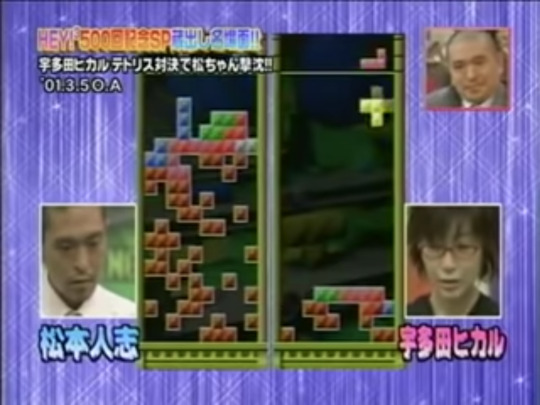
Described as having a "Parappa style aesthetic" with 2D anime style characters in a 3D environment, the game featured high speed play and items you could use to interfere with your opponent. Seeing the difficulty in differentiating the game from similar titles, they pitched a collaboration to Downtown, but they received feedback from them that adding too much might complicate the simplicity that made Tetris work so well.
Unfortunately, complications with the show's sponsor led to the end of the show, and the project was shelved soon after. Months later Mihara would return to the project, overwhelmed with desire to continue making a Tetris game.
Mihara's aim was to surpass SEGA Tetris, which he saw as the current peak of the game. The focus on speed and precision remained from it's incarnation as a competitive game, but several additions made it more palatable for beginners as well. Thanks to feedback from one of the Arika office ladies, Tetris the Grand Master implemented a new Wall Kick system. Previously, if rotating near a wall would cause a piece to collide with it, rotation would be blocked, as if the wall had physically interfered with it. With the new rotation system, the piece could now "kick" off the wall, and be moved a unit over to make rotation possible. This also had the side effect of making advanced techniques like T-Spins easier to perform (3).
Wall Kicks, alongside the Initial Rotation System (allowing you to rotate pieces before they enter the play field), and the Temporary Landing System (aka the ghost piece, which shows a preview of where your piece will land), led to more intuitive play for beginners, and raised the skill ceiling for technical play.

Many of these features would be integrated into future titles, such as Capcom's own Disney themed versus title--Magical Tetris Challenge--which credits Arika for the use of the ghost piece. The Tetris Company integrated TGM's ideas into the Tetris Guidelines, a "minimum spec sheet" for licensed Tetris titles, allowing players to easily move between various iterations of the game. Nearly every Tetris since 2001 has used the guideline, making TGM a major contributor to the shape of Tetris over the last two decades.

Ironically, it seems that those same guidelines may have been what kept the series from wider exposure. Tetris the Absolute: The Grand Master 2, often considered the peak of the series, had several deviations from the standard, including the Sonic Drop, which behaves similar to Hard Drop, allowing you to drop them instantly to the stack, but move them for a moment before they lock into place. Combined with a locking soft drop, thus enabled techniques like the Zangi-move, where you drop a piece to the the bottom then slide and lock it into place, but doing a circular motion, not unlike the motion for doing Zangief's command grab in Street Fighter.

By the time the sequel came out--Tetris the Grand Master 3: Terror Instinct--it was required to add a guideline compliant mode, and by Tetris the Grand Master ACE, the only game in the series made for a home console (4), the systems that made the series unique had been pushed more and more towards coming in line with the design of Guideline Tetris.
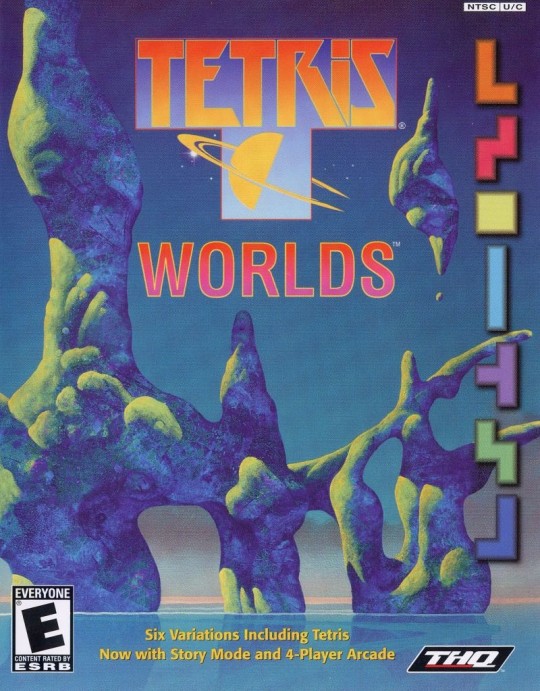
It's been speculated that the Tetris Company's reluctance to deviate from the guideline has kept the series from being re-released. Meanwhile, TGM has been developing a cult following internationally, gaining popularity among the Tetris community and building a larger awareness through demonstrations at events like Games Done Quick.
It took until 2022, nearly 25 years after its original release, for Tetris the Grand Master finally received an official port (5) through the Arcade Archives series. That was followed up this year with a port of Tetris the Absolute, finally making these cult classics widely available. The reasons why it’s now possible remain unclear, but perhaps Arika’s work on Tetris 99, and the relaxing of the Tetris Guidelines for Tetris Effect’s competitive modes helped move the needle in showing there was space for alternative Tetris experiences.
Whatever the reason, two major parts of Tetris history are finally available to a larger audience. Each is overflowing with technical nuances that I could never do justice, giving them a long term appeal that continues to this day. That's all before you get to the versus mode, which contains its own unique competitive ruleset. At the same time, their grading system gives you a tangible measure of improvement, and even casually remains an excellent way to strive towards improvement at Tetris.
As someone who developed a fighting game mindset from Puyo Puyo Tetris, it's easy to see the spirit of fighting games flowing through it. That strange magic that compels you to strive towards greater mastery, to show off your skills, it's all there. The Grand Master is a name that speaks to great ambition, but given its legacy, it's more than earned it.
Tetris the Grand Master and Tetris the Absolute Plus: The Grand Master 2 are currently available on Switch and PS4 through the Arcade Archives series. An arcade ROM to PSX conversion also exists for the first game.
---
Stack, the formal name for the collection of pieces already locked down.
This story comes from an interview series previously hosted on Arika's Japanese site. An archive of it is available here.
A T-Spin occurs when you rotate a T piece into a spot where it's locked on three sides, often used to clear a line.
TGM ACE was published on the Xbox 360, but only in Japan.
The game recieved an unofficial conversion to the Playstation, and obviously was available via arcade emulation.
#canon fire#tetris#switch#ps4#tgm#tetris the grand master#tetris the absolute#puzzle#street fighter#manzai#japanese comedy#street fighter ex#arika#capcom
45 notes
·
View notes
Text
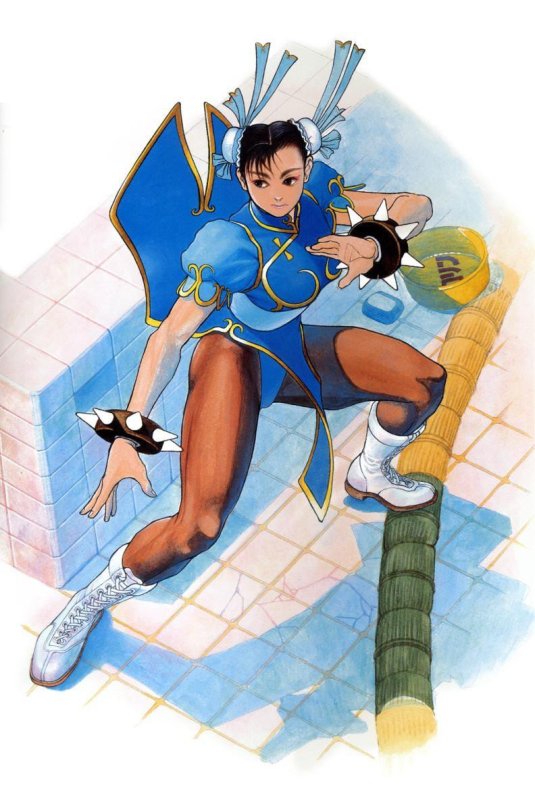
Chun-Li illustration by Akiman
#Capcom#Street Fighter#Street Fighter II: The World Warrior#illustration#arcade#video games#retro gaming#Akira Yasuda#Akiman
71 notes
·
View notes
Text

The venomously broken woman
#Video games and animations#street fighter 2 the animated movie#Street fighter series#Capcom#Akiman Yasuda#Juri Han#south Korean#Feng shui eye#Foil to Chun Li#Venomus spider aethestics#SF4 get up#GIFs#Tae kwon do practitioner
47 notes
·
View notes
Text

X-Men vs Street Fighter 1996 Video Game / Artist: Akiman Akira Yasuda
28 notes
·
View notes
Photo









Some Turn∀ Gundam DVD covers, painted by Yasuda Akira / Akiman.
2K notes
·
View notes

